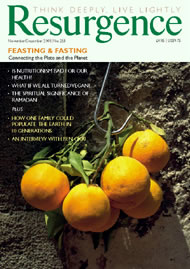LESTER BROWN’S ‘PLAN B’ series has captured endorsement from many, including Bill Clinton, Klaus Schwab, and philanthropist Ted Turner, who famously bought 3,756 copies of the book and gave them to leaders and policymakers in every country of the world. There is even a ‘Plan B Team’, a group of people who have bought five or more copies of the book to give away to influential persons in their country. The series constitutes what could be considered the benchmark for eco-audit books. Many authors do a very useful job of putting together ‘state of the planet’ reviews, but the level of detail and the interconnections between issues are what set Plan B apart.
To ‘useful’ I should add ‘terrifying’. Although they are very practical for either getting yourself an up-to-date picture of the environmental decay around the world, or introducing yourself to the subject, ‘Plan B’ books are so disturbing to read that one feels like this must surely be a fantasy – a nightmarish, dystopian vision of how things could be if the world were shaped largely by blind greed and bizarre beliefs in the finite being infinite.
What is so amazing is the difference between this work – and we can see how well researched and referenced it is – and the reality that our ‘leaders’ seem to live in. The rhetoric is so far divorced from the scientific reality and all its attendant threats to human rights, democracy, race relations, peace, justice, water supply, food production and so on. And not only politicians and business leaders, but green groups, too. The picture here says that there is far too little time left to be working as we always have. We need to do far more work on synchronising our efforts, sharing our resources and coming up with a bigger and better-co-ordinated response to these complex problems. I recently discussed this with a fellow environmentalist. She said that when she started work for one of the world’s biggest NGOs, her suggestion that all the NGOs pool their resources and work together on these issues was openly laughed at.
This is as big a part of the problem as any other, especially when the issues we have to deal with are so diverse. Brown starts here, covering the headings ‘Deteriorating Oil and Food Security’, ‘Rising Temperatures and Rising Seas’, ‘Emerging Water Shortages’, ‘Natural Systems Under Stress’ and ‘Early Signs of Decline’. He then goes into the potential solutions, addressing poverty and population, restoring natural systems, food and agriculture, cities, energy efficiency and renewable energy. The last two, renewables and efficiency, are the major new additions to this volume.
What Brown is trying to do is all that can honestly be asked of an environmentalist – to accurately identify and describe the problems, and then offer workable, effective solutions that can shape a safe, just, sustainable world. Setting out a series of proven policies and practices, alongside the grim facts of why we need them, is useful to policymakers and advocates, and all interested parties. Tools of this kind could be said to be the first part of what is necessary for changing the world for the better.
Brown is wise to focus so much on solutions in the latter half of the book. Ignorance is bad enough, but despair is utterly disabling. Indeed, it takes a great effort to make it through the ordeal of the first half. A friend once told me, “If you have an open heart and an open mind, you can suffer greatly in this world.” It is indeed a challenge to think and care deeply, especially when exposed to such an assault of heartbreaking, mind-bending facts.
The interconnectedness of issues, which so befuddles policymakers, is apparent throughout, and continues into the solutions. The chapter ‘Eradicating Poverty, Stabilising Population’ is a good example. Towards achieving these goals, Brown stacks together a number of factors including education, fertility, disease, smoking, and farming subsidies. His solutions are carefully chosen case studies which show what can be done when a decision to succeed is made.
However, what I call the ‘mosaic’ approach, this patchwork of efforts and approaches around the world – including Kyoto – is just not going to get us where we need to go, certainly in the time remaining. The ‘masterplan’ approach, on the other hand, would be an organised, strategic approach which united an atomised, confused global society, giving it purpose, combined strength and a beautiful vision. As Brown shows, we have the technology, approaches, examples and the tools for organisation, and we could make the decision to succeed in humankind’s mission for the 21st century: to preserve life on Earth. Who would say it is not worth doing?







